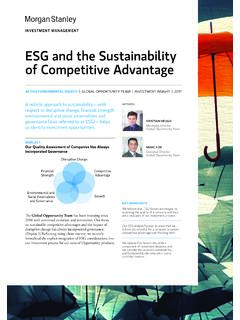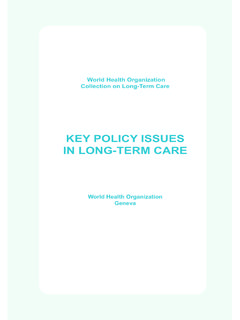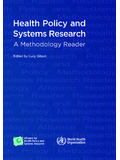Transcription of UK Influenza Pandemic Preparedness Strategy 2011 - GOV.UK
1 1UK Influenza Pandemic Preparedness Strategy 2011 UK Influenza Pandemic Preparedness Strategy 2011 2 DH INFORMATION READER BO XPolicyE statesHR / W orkforceCom m issioningManagem entIM & TPlanning / FinanceClinicalS ocial Care / Partnership W orkingDocum ent PurposeGatew ay ReferenceTitleAuthorPublication DateTarget AudienceCirculation ListDescriptionCross RefSuperseded DocsAction RequiredTimingContact Details80 London Road, LondonT his docum ent describes the Governm ent's strategic approach for responding to an Influenza pandem ic. It provides background inform ation and guidance to public and private organisations developing response plans. It takes account of the experience and lessons learned in the H1N1 (2009) Influenza pandem ic and the latest scientific evidence. N/ADH Pandem ic Influenza Preparedness Team10 Novem ber 2011 PCT CEs, NHS Trust CEs, SHA CEs, Care T rust CEs, Foundation T rust CEs , M edical Directors, Directors of PH, Directors of Nursing, Local Authority CEs, Directors of Adult SSs, G Ps, Com m unications Leads, Em ergency Care Leads, Directors of Children's SSs, Nurses, Health Visitors, Clinicians, M anagers, Com m issioners, Pharm acists, Doctors, Midwives, Param edics, Dentists#VALUE!
2 N/APandem ic Flu: A National Fram ework for responding to an Influenza pandem icN/A016463 PolicyFor Recipient's UseUK Influenza Pandem ic Preparedness StrategySE1 6LH00 Pandem ic Influenza Preparedness Team451c Skipton House Crown copyright 2011 First published 10 November 2011 Published to DH website, in electronic PDF format only. UK Influenza Pandemic Preparedness Strategy 2011 3 UK Influenza Pandemic Preparedness Strategy 2011 UK Influenza Pandemic Preparedness Strategy 2011 4 Contents 4 1. Introduction .. 6 Purpose of this document .. 7 Changes to the previous approach .. 7 2. The challenge of Pandemic 9 The uncertainty of Pandemic Influenza .. 10 Uncertainty about when an Influenza Pandemic could occur .. 11 Unpredictability about how severe a future Influenza Pandemic could be .. 11 The speed with which the Pandemic can develop .. 11 The potential impact of an Influenza 12 Potential economic impact of an Influenza Pandemic .
3 12 Lessons from the H1N1 (2009) Influenza 13 Planning assumptions for a future Influenza Pandemic .. 14 Research and Development .. 17 3. The strategic approach to Pandemic Preparedness .. 19 Strategic objectives .. 19 Precautionary: responding in relation to the 20 Proportionality: planning for 20 Flexibility: managing the phases of Pandemic 26 Proposed new UK approach to the phases of Pandemic response .. 27 Evidence based .. 29 Ethical principles for Pandemic Preparedness .. 30 Building on established systems and business 31 Whole of society Preparedness .. 31 Local and national coordination .. 32 International coordination and 33 4. Key elements of Pandemic response .. 34 Detection & 34 Reducing the spread of disease: infection control & respiratory and hand 36 Facemasks and respirators .. 37 International travel, border restrictions and screening.
4 38 Restrictions on public gatherings and public transport .. 39 School closures .. 39 Minimising serious illness and deaths .. 40 Antiviral 40 Antibiotics .. 42 Protecting people through 42 5. Communication and public engagement .. 45 Enabling people to share responsibility for Preparedness and 46 Communications for the public .. 47 Communication of statistical data in an Influenza 48 Communications for health and other 48 Suggested key messages for the public .. 49 6. The health and social care 50 Initial response Detection and Assessment phases .. 50 Treatment phase .. 52 National Pandemic Flu Service (NPFS).. 52 UK Influenza Pandemic Preparedness Strategy 2011 5 Secondary (hospital) 53 Escalation .. 54 Vaccination .. 55 Recovery 55 7. Whole of society 57 Business as 57 Maintaining essential services and normal 57 The role of the military.
5 60 Health and 60 Maintaining public 61 The role of the 61 Managing deaths .. 62 Taking legislative 62 8. Further information .. 64 65 67 UK Influenza Pandemic Preparedness Strategy 2011 6 1. Introduction Each year, seasonal Influenza affects many thousands of people in the UK. Occurring mainly in winter, it is an infectious respiratory disease capable of producing symptoms ranging from those similar to a common cold, through to very severe or even fatal. It brings about variable effects in successive winters and in some years causes intense pressure on health and social care services and significant levels of absence from the workplace and schools. From time to time, with unpredictable frequency, a distinctly different strain of Influenza virus will emerge that spreads rapidly across the world, causing an Influenza Pandemic .
6 The World Health Organization (WHO) currently defines a Pandemic as: .. the worldwide spread of a new disease. An Influenza Pandemic occurs when a new Influenza virus emerges and spreads around the world, and most people do not have immunity. 1 When an Influenza Pandemic occurs, large swathes of the population may become infected by the new virus over a relatively short period of time. It may be associated with mild to moderate illness in the population (which may or may not be widespread), or significant severe illness and mortality in certain age or patient groups, and may significantly disrupt the normal functioning of society. It is necessary to mobilise the collective efforts of society in order to manage the impact of a Pandemic . For these reasons, a new Influenza Pandemic continues to be recognised as one of the greatest threats facing the UK.
7 In many respects, Pandemic Influenza can be responded to in the same way as seasonal Influenza . The same good hygiene measures can reduce the spread of infection. The same self-care measures staying at home, keeping warm, drinking plenty of fluids and the use of over the counter cold and flu medicines - should be sufficient to meet the needs of most patients infected with an Influenza virus that causes mild to moderate symptoms. However, additional plans, over and above those for seasonal Influenza , are needed for Pandemic Influenza to: Ensure that we are able to detect the emergence of a new virus and its arrival in the UK as quickly as possible and to determine the severity of illness, age groups and populations most affected and how transmissible it is. 1 WHO website: Pandemic (H1N1) 2009: frequently asked questions: what is a Pandemic ?
8 UK Influenza Pandemic Preparedness Strategy 2011 7 Take account of the potentially much greater number of people who will become ill with Influenza and / or experience more severe symptoms and of the resulting potential impact on both the health system and the wider economy. Prepare for an Influenza Pandemic that may have a high impact on the health system and wider society. Whilst Influenza pandemics have been relatively infrequent over the past century, a new Pandemic could emerge at any time. Plans for responding to any Influenza Pandemic build on and enhance normal business continuity planning for more routine pressures such as bad weather and winter illness. Pandemic Preparedness is therefore an integral part of wider emergency response and Preparedness . Purpose of this document The UK has been preparing for an Influenza Pandemic for some years.
9 These preparations were tested by the H1N1 (2009) Influenza Pandemic although, in comparison with previous Influenza pandemics, the H1N1 (2009) Influenza Pandemic was very mild. The response to the H1N1 (2009) Influenza Pandemic was the subject of an independent review chaired by Dame Deirdre Hine2. This document describes proposals for an updated, UK-wide strategic approach to planning for and responding to the demands of an Influenza Pandemic . It builds on, but supersedes, the approach set out in the 2007 National framework for responding to an Influenza Pandemic (and the Scottish equivalent), taking account of the experience and lessons learned in the H1N1 (2009) Influenza Pandemic and the latest scientific evidence. An overview of the science underpinning the proposals is being published in parallel with this document.
10 This Strategy is intended to inform the development of updated operational plans by local organisations and emergency planners. Changes to the previous approach Whilst the overall approach is not substantially different from the 2007 National framework , there are a number of key changes, reflecting the lessons learned following the H1N1 (2009) Influenza Pandemic and the recommendations of the independent review and other reports. Chief among these are the need to: Develop better plans for the initial response to a new Influenza Pandemic , when the focus should be on rapid and accurate assessment of the nature of the Influenza virus and its effects, both clinically and in relation to wider public health implications. 2 Hine, Dame Deirdre. The 2009 Influenza Pandemic : An independent review of the UK response to the 2009 Influenza Pandemic .













